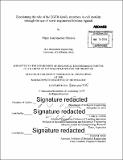| dc.contributor.advisor | Linda G. Griffith. | en_US |
| dc.contributor.author | Sanchez Palacios, Edgar Ivan | en_US |
| dc.contributor.other | Massachusetts Institute of Technology. Department of Biological Engineering. | en_US |
| dc.date.accessioned | 2015-07-31T19:10:27Z | |
| dc.date.available | 2015-07-31T19:10:27Z | |
| dc.date.copyright | 2015 | en_US |
| dc.date.issued | 2015 | en_US |
| dc.identifier.uri | http://hdl.handle.net/1721.1/97977 | |
| dc.description | Thesis: Ph. D., Massachusetts Institute of Technology, Department of Biological Engineering, 2015. | en_US |
| dc.description | Cataloged from PDF version of thesis. | en_US |
| dc.description | Includes bibliographical references. | en_US |
| dc.description.abstract | Non-small cell lung carcinoma (NSCLC) is the most common type of lung cancer and is the leading cause of cancer related mortality worldwide. The past decade has seen exciting advances in the development of targeted therapies for the treatment of NSCLC. However, the efficacy of such therapies in prolonging patient survival has been disappointing, and there remains an urgent need for a greater understanding of the molecular events involved in tumor progression and metastases. MET and members of the epidermal growth factor receptor (EGFR)- family are cell-surface receptor tyrosine kinases (RTK) commonly upregulated in NSCLC cells, and their signaling crosstalk can confer therapy resistance. The four EGFR-family members are similar in structure; each contains a ligand binding domain, a transmembrane region, and a phosphotyrosine cytosolic domain. Upon ligand binding, each of the family members dimerizes in a homo- or heterotypic manner to initiate signaling cascades that influence migration and proliferation outcomes. This thesis describes the use of engineered bivalent ligands to systematically manipulate receptor dimerization, perturb downstream signaling processes, and affect phenotypic outcomes. Results showed that biasing away from an EGFR-HER-2 with a bivalent ligand reduces cell motility significantly in a stem-cell model cell line, but does not inhibit cell proliferation or cell survival. Furthermore, reengineering ligands with varying intraligand distance showed that this inhibition of motility is distance-dependent. Lastly, a Neuregulin-Neuregulin (NN) ligand disrupts the crosstalk between MET and Her-3 receptor to reduce hepatocyte growth factor (HGF)-induced cell motility. Based on these results, a mass spectrometry (MS)-based phosphoproteomics approach to quantitatively map cellular signaling events mediated by Her-3 downstream of Met proceeded. The thesis concludes by quantitatively exploring the relationship between the measured signals of phosphorylated proteins and the cellular migration phenotypes, seeking novel potential therapeutic targets. Overall, this work illustrates the complexity of the EGFR signaling pathway and the need for new paradigms to target its signaling pathway to advance our knowledge in developing new therapeutic approaches. | en_US |
| dc.description.statementofresponsibility | by Edgar Ivan Sanchez Palacios. | en_US |
| dc.format.extent | 138 pages | en_US |
| dc.language.iso | eng | en_US |
| dc.publisher | Massachusetts Institute of Technology | en_US |
| dc.rights | MIT theses are protected by copyright. They may be viewed, downloaded, or printed from this source but further reproduction or distribution in any format is prohibited without written permission. | en_US |
| dc.rights.uri | http://dspace.mit.edu/handle/1721.1/7582 | en_US |
| dc.subject | Biological Engineering. | en_US |
| dc.title | Elucidating the role of the EGFR-family members in cell motility through the use of novel engineered bivalent ligands | en_US |
| dc.type | Thesis | en_US |
| dc.description.degree | Ph. D. | en_US |
| dc.contributor.department | Massachusetts Institute of Technology. Department of Biological Engineering | |
| dc.identifier.oclc | 914167512 | en_US |
